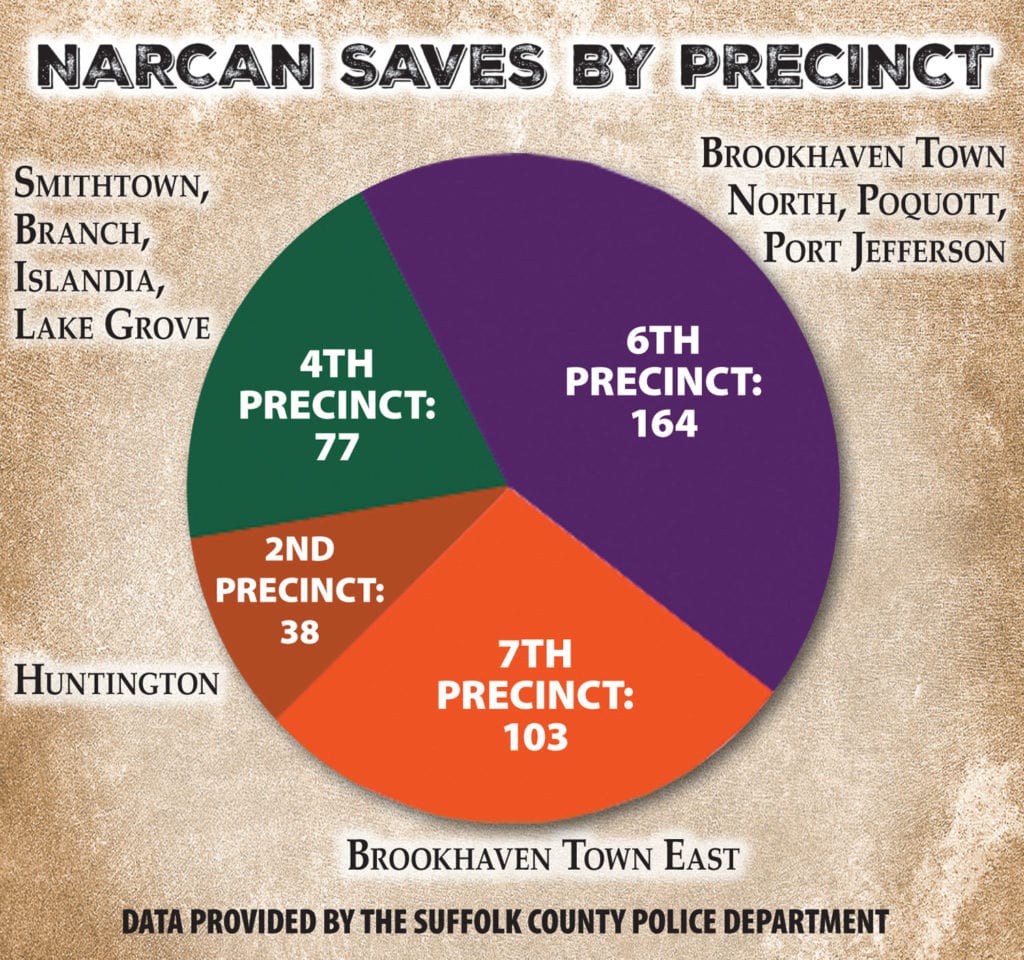
Commentators on the rising opioid crisis in the United States commonly say dealing with the problem requires a multi-pronged approach, and the Suffolk County Police Department agrees.
The department has expanded efforts to combat the many fronts of the opioid crisis, including prevention, treatment and enforcement.
Police Commissioner Tim Sini said in an interview that the opioid problem is the number one public safety and public health issue in Suffolk County.
“We have over 100 opioid-related overdoses every year for the past several years, and then when you consider the more than 500 Narcan saves on top of that, the tragic loss of life and the near tragic loss of life is just shocking,” he said at police headquarters in Yaphank.
It’s no secret the SCPD has their job cut out for them — in 2014 Suffolk County had the highest number of overdose deaths involving heroin, and was the leader in deaths where prescription opioids were a factor in the state, according to a report by the New York State Comptroller’s office from June.
In 2014 Suffolk County had the highest number of overdose deaths with heroin, and was the leader in deaths where prescription opioids were a factor in NY
Sini also highlighted how crime is so closely associated with an increase in drug activity.
“Addicts often resort to burglaries and larcenies, and sometimes they elevate to robberies,” he said. “And now we’re seeing our gangs getting involved in the heroin trade because there is a lot of money to be made and there are so many customers.”
The commissioner said the department is working as hard as it can to ensure it’s as inconvenient as possible to sell drugs in Suffolk County.
At the end of March, SCPD started a program that encourages residents to call 631-852-NARC, an anonymous hotline encouraging residents to call in with drug tips they have. If the tip leads to an arrest, the resident is entitled to a cash reward. This initiative works in conjunction with Crime Stoppers, a program that connects local police departments with the public and media to help find suspects and collect information that can lead to arrests.
“Since we rolled [the drug hotline] out at the end of March, we’ve received over 500 tips on that line, and many of those have resulted in investigations and search warrants,” Sini said. “We’ve seized kilogram quantities of narcotics as a result of this initiative, over a million dollars in drug money, dozens and dozens of weapons, and over 200 arrests under this initiative. It’s important because not only does it take drugs off the street but it sends the message that we’re not going to tolerate drug dealing in our communities.”
The police department has said open communication with the public is an important part of this fight, because the more communities speak up and help the department, the better work the police can do.
Sini said since he took over, there has been almost a 200 percent increase in the amount of search warrants executed, and many of these are due to tips from residents.
“[Search warrants] are very important because it disrupts drug operations before they become too significant,” Sini said. “It takes guns and drugs off the streets, and also strengthens the partnership between the police department and the community. It encourages people to be more informative.”
Relationships with federal law enforcement partners have also been re-established, Sini said, and five detectives now work with the Drug Enforcement Administration; four focus on the heroin trade and the fifth investigates doctors and pharmacists who have been reported to unlawfully dispense or prescribe pain medication.
The police department has also focused resources on treating drug addicts who are in the throes of addiction.
Inmates at the Suffolk County Correctional Facility in Yaphank have the option of receiving voluntary medical assistance while still in jail. The department offers inmates who are eligible for the program, meaning they don’t have any drugs currently in their system and have said they want to commit to getting clean, an injection of Vivitrol, a drug that works as an opioid antagonist, blocking the opioid receptors in the brain and preventing someone from getting high for 30 days.
“It gives you that mental clarity and stability to essentially not relapse, so you can stay in treatment,” Sini said. “It’s highly effective but most addicts don’t want to use it because once you take that shot, you know you can’t get high for thirty days. So it takes someone who is really committed to getting help.”
Sini said the program starts in jail, and they look for inmates who have essentially been incarcerated because they are addicted to drugs, with arrests due to burglaries, possession, and other drug-related crimes. Incarcerated individuals receive their first shot in jail, and then are set up with a treatment provider in their community to work with when they are released.
“This is a multifaceted problem that creates issues for families, schools, the police department, probation, courts, medical examiners, churches and more. And everyone has got to be at the table.”
— Tim Sini
Suffolk County officers are also dedicated to providing programs that help with prevention.
The Ugly Truth is a program meant to educate school districts and community groups on the dangers this growing problem poses for all different age groups in Suffolk County. There are many other programs in effect right now being taught throughout the county.
“If we can prevent someone from ever going down that road, that’s where you’ll get your biggest bang for your buck,” Sini said.
The commissioner said he is only interested in working with evidence-based programs, which are resources that have been studied by analysts to prove their effectiveness.
Certain police officers are also designated as school resource officers. They are assigned to specific districts to participate in awareness programs with the students.
Sini said despite all the resources the department provides, more needs to be done.
“The silver lining is, among the experts there is consensus,” Sini said. “We don’t sit there and debate if addiction is a disease or if the cops can solve this problem. We all get it; this is a multifaceted problem that creates issues for families, schools, the police department, probation, courts, medical examiners, churches and more. And everyone has got to be at the table.”






